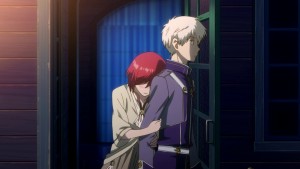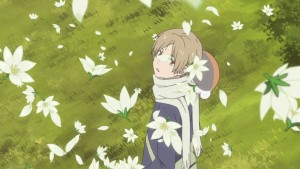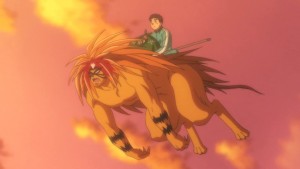Is the Top 10 list the best measure of an anime year? It’s the most obvious one certainly. And if one prioritizes the elite series above all else, there’s certainly no better metric. But I’ll say this much: the second 10 can say just as much or more about what kind of year it was. And in 2016, I think that’s very much the case.
Looking back at my Top 10 list, it stands as a good one. Maybe the best since 2012, or at least in the running. But as a group I think the 11-20 shows are even more impressive. There are at least five or six series in this group which reflexively feel like top 10 shows to me, and that’s a larger number than I’ve seen since 2012 for sure. What’s more, there’s another pod of series that didn’t make this list that absolutely have the requisite quality of Top 20 entries. 2016’s Top 10 is good, 11-20 is excellent, but if there were a 21-30 list that might be the most comparatively impressive of the lot.
The takeaway, then, is that while 2016 was a very solid year for anime as a whole (which is certainly welcome, as it interrupted a three-year downward trend), it was strongest in terms of depth rather than elite quality at the top. Here, then, is a very impressive group of anime:
11. Fune wo Amu – NoitaminA ended 2016 as it began it, with a series very true to its roots as a venue for anime that don’t fit the conventional commercial mold. The Great Passage was at its best when it didn’t attempt to be a conventional anime (which happily was most of the time) and finished with a truly inspiring and emotional finale, a defiant defense of literacy and intellectual freedom. Passion comes in many forms, and Fune wo Amu chose to celebrate a sort rarely celebrated in anime or anywhere else.
12. Akagami no Shirayukihime – Bones barely missed equalling Madhouse’s 2016 milestone of four series in the Top 10. And in most years Akagami no Shirayukihime would have qualified – it certainly would have in 2015 if it hadn’t been a split-cour and thus ineligible under the rules I’ve been applying to these lists. That’s not because the second cour was weaker than the first (though it may have been, by just a hair) but simply because the competition was that much better. This was the best pure romance show of 2016, a refreshingly low-key and relaxed shoujo fantasy. The manga, by the way, gets even better after the anime leaves it – I strongly encourage you to read it if you enjoyed the anime.
13. Natsume Yuujinchou Go – It’s funny that the last two seasons of Natsume Yuujinchou have missed out on the Top 10 list, because it’s not as though the series has declined in quality. Maybe it gets punished for consistency – there’s no question that this series is very good at delivering what it’s best at over and over. “Go” was another rock-solid season, perhaps falling short of the franchise’s top tier only due to its curtailed length and the absence of more than a couple of those truly sublime episodes.
14. Ushio to Tora – UshiTora is another split-cour show that would have made the 2015 Top 10 list, and missed only because of the caliber of the competition. MAPPA did a really strong job with Fujita Kazuhiro’s old-school shounen classic, and I think bringing him in to help on series composition was a very smart move. Rather than dated, Ushio to Tora plays as pleasingly nostalgic and timeless – shounen as it once was, in a simpler age. I know a lot of material was cut to get the anime down to three cours, but as an anime-only viewer it worked well for me, because the pacing was insistent and there was a sense that everything happening on-screen really mattered.
15. Yuri!!! on Ice – As a cultural phenomenon, perhaps no other 2016 anime apart from Osomatsu-san exceeds the impact of Yuri!!! on Ice. Rarely do we see anime get as much attention in the Muggle world os YoI, which understandably became quite the sensation among the Western figure skating community. The humor was hit-and-miss for me, but on balance I think Yuri!!! worked well both as a sports anime and a romance – and obviously, in the latter category it deserves a great deal of credit for depicting a gay male couple without resorting to BL tropes or pandering. For me it’s Yamamoto Sayo’s best work, hands-down, and I’ll be interested in seeing what she and Kubo decide to do in the inevitable second season.
16. Kono Bijutsubu ni wa Mondai ga Aru! – Konobi was one of my favorite comedies of 2016, a strong year for them. It’s a thoroughly delightful and quintessentially anime comedy, a perfect blend of sweet and snark and charmingly innocent ecchi. The main couple is exquisitely mismatched and the supporting cast generally hilarious. The latter is especially crucial as it’s a trait that allows a comedy series to succeed using a wide range of styles, as Konobi certainly does. It’s also one of the best-looking anime comedies in a long time, and really benefits from its smart and realistic depiction of middle-schoolers as something besides slightly smaller high-schoolers or oversized grade-school kiddies (which are the usual anime approaches to this age group). Once again I heartily recommend the manga if you like the anime, as it’s likewise great.
17. ReLIFE – Whatever you think of the conceit at the heart of ReLIFE’s plot, the anime does a wonderful job of mining it for genuine drama and winning comedy. Kaizaki is one of the more likeable and relatable protagonists in anime this year, and Hishiro a perfect foil. Too much time is wasted on subplots that have a whiff of conventional high-school fluff to them, and Kariu’s arc takes up way more screen time than it should. Still, ReLIFE is a very strong take on adult responsibilities and the notion that who we are is largely hard-wired by the time we become teenagers.
18. Girlish Number – This series was completely off my radar until I was prodded into watching it by several sources I trust, and darned if they weren’t right. Watari Wataru’s world-weary snark really soars when freed from the LN tropes implicit in the high-school setting of Oregairu, and he’s pretty fearless (and accurate) in his satire of the dysfunctional anime industry as it exists in 2017. But what really makes Girlish Number work as entertainment is that it becomes quite an effective character-driven story in the second half, wisely choosing to focus on the impact the problems facing anime have on those who work in it rather than carp incessantly on the problems themselves.
19. Ajin – If Ajin is #19 on this list, you know 2016 must have been a pretty damn good year. Sure the character animation is atrocious, but the writing is so good that by the end you’ve almost forgotten about that. Ajin isn’t so much a conventional sci-fi anime as a Hollywood thriller with a Japanese accent, and a fine one at that. There’s rarely a wasted moment, and Satou is one of the best antagonists we’ve seen in anime for ages.
20. Dimension W – There’s something very Bones-like in Studio 3Hz’ adaptation of Iwahara Yuji’s sci-fi seinen manga (and of course he’s worked with Bones before). This isn’t Bones, of course, and there are some definite drops in animation and background detail over the course of the series, but at its best Dimension W is still a really cool-looking and stylish piece of work. There’s some sense of untapped potential in this adaptation, but I still think this is a very good premise and Dimension W delivers some stellar moments over the course of its run.
Because this is my list and I can, I’m going to single out several more series that really deserve recognition – because they’re simply too good to be left out just because 2016 was such a deep year (and it’s no coincidence four of them are sequels to series that made the Top 20 originally). In no particular order those shows are:
- Kyoukai no Rinne Season 2
- Dagashi Kashi
- Haikyuu!!: Karasuno Koukou VS Shiratorizawa Gakuen Koukou
- Planetarian
- Shokugeki no Souma: ni no Sara
- Binan Koukou Chikyuu Bouei-bu LOVE! LOVE!








Flower
January 1, 2017 at 8:25 pmInteresting how we have a very, very (almost eerily) similar “top 20” series … what differs is the order in which we select them all. For example Fune wo Amu was #11 for you, #3 for me, Concrete Revolutio was #7 for you, #4 for me, Shouwa Rakugo was #2 for you, #11 for me, and so on.
Two big differences are out top choice, but both of them were, we felt, masterful adaptations of a source manga we loved and enjoyed and which series we were anticipating the anime adaptation of almost from the first day it was announced! XD
Guardian Enzo
January 1, 2017 at 8:42 pmYeah, Flying Witch (your top pick) would have been on my 20-30 list somewhere – I really did enjoy it. There are some definite disagreements there (Grimgar!), which mostly reflect our differences in taste. But for the most part, quality is quality…
Simone
January 2, 2017 at 4:57 amGrimgar had a weird quality in that I feel the biggest discriminant about it was whether you were able to stomach Ranta or not. I wasn’t. It was kind of a pity because it looked very pretty and scenes like the goblin battle in episode 2 were clearly inspired, but…
…fucking Ranta.
Flower
January 2, 2017 at 8:36 amGrimgar definitely was not for everyone. But for me it really resonated. What can I say?
If I remember correctly, though, Enzo’s main complaint about it was not so much character driven as an aspect of the presentation that rubbed him the wrong way quite strongly, and he could not “not see” it.
A generally similar thing also happened with me with Yuri on Ice, although his complaint with Grimgar and mine with Yuri on Ice were different ones they were both related to a manner of presentation and really got in the way of being able to appreciate those series.
It happens sometimes.
Guardian Enzo
January 2, 2017 at 8:46 amGrimgar… Too many LN cliches. And to me at least, it was one of the most insidiously misogynist shows I’ve seen in a long time. Objectification is one thing – this was something entirely more disturbing than that, at least for me. Different strokes.There was obviously some interesting stuff there in terms of the unvarnished brutality in the depiction of a too-familiar premise, but not nearly enough to counteract the negatives for me.
Simone
January 2, 2017 at 8:48 amWell, I don’t remember the details, but Ranta was basically a stand-in for everything light-novelish in that show. Stupid titty jokes? Ranta. Casual sexual harassment? Ranta. Edgy kid bullshit? Ranta. I mean, he was not necessarily *THE* problem, but he became the one character in whose mouth and actions all the worst writing would wind up.
Akka
January 2, 2017 at 10:46 amHoly cow, I forgot that Akagami no Shirayuki was eligible for 2016. Pretty surprised it didn’t make it to your top10, considering you have a much bigger soft spot for shojo/josei than I, and yet I would have put it right up there easily ^^
This 11-20 wouldn’t look bad as a top 10 of any regular year. 2016 was really impressive – I hope it’s not a swan song for anime.
Color2413
January 2, 2017 at 12:14 pmFor me, Ajin was ranked much higher (probably #3) on the strength of a script that made every episode fly by. After each ep, I could hardly wait to see what happened next. I found it easy to move beyond the idiosyncratic CGI and just get caught up in the story.
I would also have ranked Yuri higher, based on the sheer amount of animation (I don’t know how they did it on a TV budget), the sympathetic characters, excellent pacing, and of course, a romance that broke out of the “BL ghetto” and into the mainstream.
Rita
January 2, 2017 at 5:03 pmI guess this means you read the manga for Akagami no Shirayukihime after the anime ended then. I adored the Lyrias arc so I hope that’s the better manga continuation material you’re talking about (although I love most of the series in general).
2016 was one of those years that I keep forgetting was great. Not because there weren’t enough good shows or anything, in fact I think it was because there were too many. It felt like, for once, a continuous flow of seasons with shows I liked. Whereas during other years I’ll tend to get one season with a bunch of shows I like and the others are ok or so and you can really feel the impact of a single great series more during those years.
Guardian Enzo
January 2, 2017 at 5:06 pmYep, I love the Lyrias Arc to death. It’s funny one with Shirayuki and Zen mostly not together is so great, but she and Ryuu are great together.
Ouki’s Majestic Lips
January 2, 2017 at 10:14 pmHonestly, while my personal Top 20 List may differ slightly from yours, Enzo (I personally put Flying Witch and KonoSuba in my list, but what is life without a little difference in personal tastes), I feel that the only real difference in placement I would have with your list would be to switch the placements of Ushio to Tora and My Hero Academia. Again, please do not take this as ay form of criticism on your analytical abilities, far from it, but just as a simple difference of opinion. Like your season review of MHA mentioned, the 1st season really felt like it was just scratching the surface of the story’s narrative and potential, and while Bones might’ve nailed the feeling and spirit of the manga, I can’t help but feel that Ushio to Tora deserves just as much praise in that department, if not more, considering the fact that MHA managed to be an almost panel-for-panel recreation of the manga chapters it adapted, Ushio to Tora had to condense 300+ chapters of manga into a coherent 39 episode series, which it did in spades.
I personally believe that judging the 1st season of MHA on its own merits and not the potential that future seasons may yet hold, I think (for obvious reasons) Ushio to Tora outshined it both as a love-letter to old school anime, and as an adaptation that remains true to the spirit of the source material. It tells a complete narrative as opposed to the opening act that is season 1 of MHA, avoids the dangers of updates or modernizations, and manages to maintain a consistent and entertaining level of animation.
All in all, I just think that while the future remains bright for MHA, 2016 was the year of Ushio to Tora
Earthlingzing
January 5, 2017 at 11:22 amIts easy to dismiss Fall 2016 as the weakest season of 2016, but looking at this list I’m surprised how many good series there were coming from that season. Half of the series here aired in Fall, and based on the quantity of good shows it might just have beaten Winter or Spring.